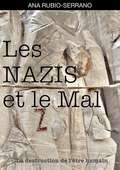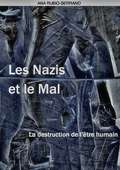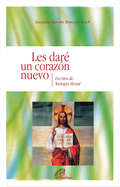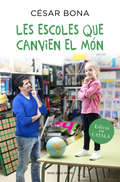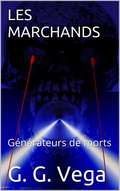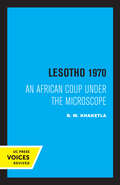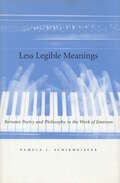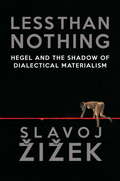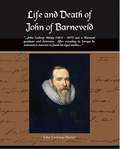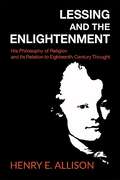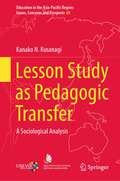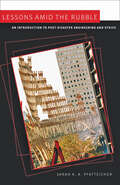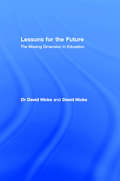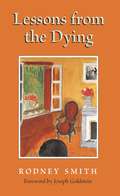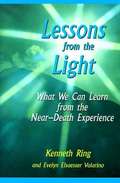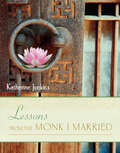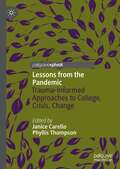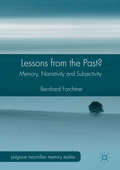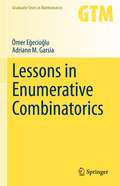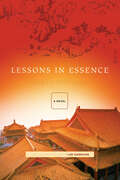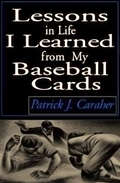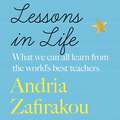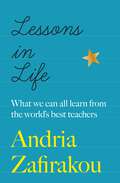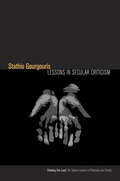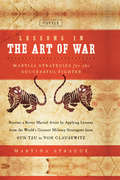- Table View
- List View
Les Nazis et le Mal. La destruction de l'être humain
by Ana Rubio-SerranoLes Nazis et le Mal. La destruction de l'être humain par Ana Rubio-Serrano. (Nouvelle édition) Le Nazisme a ouvert la porte au terrorisme global. Il a dessiné un mal structurel où personne n'était sûre, pas même le peuple allemand. L'ennemi : tout celui pouvant penser par lui-même de façon libre et différente à ce que les règles nazies le dictaient. Les aryens n'étaient que des "individus créés", conçus pour la violence, c'est-à-dire, des automates intelligents déshumanisés. La socialisation du crime à travers la violence devenue en culture a été l'un des objectifs que l'on a pu établir dans les camps et dans la société. Bien que plus de soixante-cinq ans se sont écoulés depuis qu'Hitler monta au pouvoir en Allemagne, le sujet du Nazisme et de l'Holocauste est encore un des sujets pertinents, en gardant en vie les questions suivantes : Comment cela a-t-il pu arriver ? Et quelles sont les conséquences de ce qui a eu lieu ? Ces questions sont abordées dans "Les nazis et le mal, la destruction de l'être humain", publié par Éditorial UOC sous la marque Niberta et avec un prologue du Chaire en éthique à l'Université de Barcelone, Norbert Bilbeny. Ce qui est, d'abord, une question très vaste, est réduite à une enquête exhaustive de la notion du mal chez les hommes du Troisième Reich ou ce qui est équivalent au Même, le processus de comment les êtres humains deviennent méchants, ce qui se matérialise dans le Troisième Reich. On pourrait penser que le sujet concernant le Nazisme est déjà surchargé de références et qu'il serait difficile d'ajouter de nouveaux éléments à la réflexion sur cette question. Cependant, à peine quelques décennies représentent un bref intermède dans l'histoire dans son ensemble et la complexité du mal Nazi continue à nous troubler ; surtout, il est terrifiant d'être conscient du degré réel du mal atteint par des personnes qui, comme nous, vivaient dans de
Les Nazis et le Mal. La destruction de l’être humain
by Zaida Machuca Inostroza Ana Rubio-SerranoLes Nazis et le Mal. La destruction de l'être humain. par Ana Rubio-Serrano Le Nazisme a ouvert la porte au terrorisme global. Il a dessiné un mal structurel où personne n'était sûre, pas même le peuple allemand. L'ennemi : tout celui pouvant penser par lui-même de façon libre et différente à ce que les règles nazies le dictaient. Les aryens n'étaient que des "individus créés", conçus pour la violence, c'est-à-dire, des automates intelligents déshumanisés. La socialisation du crime à travers la violence devenue en culture a été l'un des objectifs que l'on a pu établir dans les camps et dans la société. Bien que plus de soixante-cinq ans se sont écoulés depuis qu'Hitler monta au pouvoir en Allemagne, le sujet du Nazisme et de l'Holocauste est encore un des sujets pertinents, en gardant en vie les questions suivantes : Comment cela a-t-il pu arriver ? Et quelles sont les conséquences de ce qui a eu lieu ? Ces questions sont abordées dans "Les nazis et le mal, la destruction de l'être humain", publié par Éditorial UOC sous la marque Niberta et avec un prologue du Chaire en éthique à l'Université de Barcelone, Norbert Bilbeny. Ainsi, le livre commence par décrire comment le Nazisme a introduit son pouvoir sur la société allemande grâce à sa forte structure. La globalisation du Mal est la première des quatre parties dans lesquelles le livre est divisé et dans ce livre, nous trouvons essentiellement une description détaillée du processus de la façon dont la société s'est plongée dans le mal/est devenue maligne, ce qui nous permet de parler de la médecine Nazie, la loi Nazie, le racisme antisémite élaboré, la dimension religieuse du nazisme et l'utilisation nazie de la langue. Nous lisons aussi comment, dans le but d'atteindre ses objectifs, le Nazisme savait très bien comment rassembler une variété de frustrations sociales - nous pourrions même les appeler "l
Les daré un corazón nuevo
by Eduardo Bonnín BarcelóContiene una colección de artículos, en los que el autor intenta mostrar que la teología moral católica no puede ser ni alienante ni opresiva, aunque a veces lo haya sido por desviarse del Evangelio. Su intención es procurar que el Pueblo de Dios pase de una moral legalista a una moral de la libertad de los hijos de Dios.
Les escoles que canvien el món
by César BonaEl nou llibre de César Bona ens convida a conèixer de primera mà alguns dels casos més meravellosos que estan succeint en l'àmbit educatiu, excel·lents exemples de que l'educació dels nostres fills, la manera d'ensenyar-los, es pot fer d'una altra manera i, el millor de tot: que funciona. Hi ha escoles que estan canviant l'educació. No són a Finlàndia ni a Suècia, són aquí. Unes són rurals i altres públiques, algunes tenen alumnes d'infantil i de primària, altres, a més, de secundària, de batxillerat o d'FP, però totes són «escoles Changemarker» i estan preparades per liderar una autèntica transformació educativa. César Bona ha viatjat a set ciutats i pobles seguint el camí d'algunes de les escoles que lluiten perquè cada nen i cada nena tingui l'oportunitat de convertir-se en un agent de canvi. Aquests centres compten amb alumnes motivats, mestres compromesos i pares còmplices. Escoles excel·lents des d'un punt de vista acadèmic, amb un projecte integral en el qual el respecte, la creativitat, la imaginació, el treball en equip, l'empatia, la interacció amb el barri i amb la societat són el millor camí per completar l'ensenyament de les assignatures tradicionals. L'autor ha entrevistat a mestres, pares i alumnes i ens narra, amb una veu personal i propera, els projectes que estan duent a terme, el que han aconseguit i com tots nosaltres, sigui quina sigui la nostra edat, podem aportar-hi molt. No hem d'oblidar que els nens no són els adults del demà, són els habitants del present. Si reforcem la seva creativitat natural, la seva imaginació desbordant, i treballem l'empatia, la solidaritat i el respecte, poden canviar el món. No en el futur, sinó ara. Perquè una nova educació no és un somni, és una realitat.
Les marchands
by Guido Galeano Vega Julien SaunierL’éducation appropriée de valeurs sociales humaines est la priorité dans le monde. N’importe qui ayant administré et mené l’économie mondiale, consciemment ou non, de manière intentionnelle ou non, est focalisé sur l’industrie de la mort sur la planète. Cela peut se percevoir par tous les évènements violents que notre génération, supposée évoluée, a souffert. En un siècle, des millions et des millions de ressources ont été gaspillées, et millions et des millions de personnes ont été tuées, en pleine force de l’âge. Apparemment, une partie de l’humanité a perdu l’amour de la vie, et se rue dans les bras de la mort, comme serviteur volontaire pour tuer. Ceux qui tuent sont ceux qui privent la société de recevoir les fruits positifs de la productivité globale. Ce sont ceux qui accumulent les fruits de l’effort et du sacrifice des autres. Ceux qui tuent sont ceux qui investissent les ressources de la planète dans l’industrie de la mort.
Lesotho 1970: An African Coup under the Microscope (Perspectives on Southern Africa #5)
by B.M. KhaketlaThis title is part of UC Press's Voices Revived program, which commemorates University of California Press’s mission to seek out and cultivate the brightest minds and give them voice, reach, and impact. Drawing on a backlist dating to 1893, Voices Revived makes high-quality, peer-reviewed scholarship accessible once again using print-on-demand technology. This title was originally published in 1972.
Less Legible Meanings: Between Poetry and Philosophy in the Work of Emerson
by Pamela J. SchirmeisterExamining both why and how Emerson evades the ancient quarrel between literature and philosophy, this book entirely rethinks the nature of Emerson's radical individualism and its relation to the possibility of an ethics and a politics. The author argues that the quarrel between literature and philosophy never took place in America, and that instead traditional philosophical work staged itself here as a form of literary praxis and cultural therapeutics. Epitomized in the work of Emerson, this praxis takes shape explicitly in Emerson's understanding of democracy and occurs as an exchange within the act of reading. This is the exchange that Emerson so eloquently calls for in "The American Scholar" under the name of "letters." Emerson's project for American letters is the creation of a new national identity; as Less Legible Meanings makes clear, we have not yet understood the full range of implications that this project entails. After situating American letters in relation to German and British Romanticism and the features of American culture that augmented and altered their reception in the United States, the book goes on to explore the type of reading that Emersonian rhetoric engenders. Both persuasive and tropological, this rhetoric elicits from the reader something similar to psychoanalytic transference. Its goal is to lead the reader to a point at which representational logic breaks down so that a new subject can take shape. The purpose of such rhetoric, however, extends well beyond personal self-creation, because the construction of the subject emerges as the very possibility of the passage from the private sphere to the public one. In this passage, our entire notion of liberal individualism must be rethought, and with it, the pragmatic question of Emersonian ethics and politics. A revisionary study of some of Emerson's central essays, Less Legible Meanings also invites the reader to reconsider the nature of Emerson's influence on contemporary American culture and to discover new ways in which we might continue to understand his work. Interdisciplinary in scope, the book makes equal use of the history of philosophy, psychoanalytic theory, and cultural history.
Less Than Nothing
by Slavoj ZizekFor the last two centuries, Western philosophy has developed in the shadow of Hegel, an influence each new thinker struggles to escape. As a consequence, Hegel's absolute idealism has become the bogeyman of philosophy, obscuring the fact that he is the defining philosopher of the historical transition to modernity, a period with which our own times share startling similarities. Today, as global capitalism comes apart at the seams, we are entering a new period of transition. In Less Than Nothing, the product of a career-long focus on the part of its author, Slavoj i ek argues it is imperative we not simply return to Hegel but that we repeat and exceed his triumphs, overcoming his limitations by being even more Hegelian than the master himself. Such an approach not only enables i ek to diagnose our present condition, but also to engage in a critical dialogue with key strands of contemporary thought--Heidegger, Badiou, speculative realism, quantum physics, and cognitive sciences. Modernity will begin and end with Hegel.From the Trade Paperback edition.
Lesser Hippias
by PlatoPlato studied under Socrates and was Aristotle's teacher. Together these three Greeks developed the basis of philosophical thinking for the entire Western world. Plato was also a writer, mathematician, and founder of the Academy in Athens, which was the first university in Europe. Lesser Hippias is also known as Hippias Minor. This is thought to be one of Plato's earlier works in which Socrates matches wits with the literary critic Hippias. From Wikipedia " Hippias believes that Homer can be taken at face value, and that Achilles may be believed when he says he hates liars. Socrates argues that Achilles is a cunning liar who throws people off the scent of his own deceptions, and that cunning liars are actually the "best" liars. Socrates proposes, possibly for the sheer dialectical fun of it, that it is better to do evil voluntarily than involuntarily. His case rests largely on the analogy with athletic skills, such as running and wrestling. He says that runner or wrestler who deliberately sandbags is better than the one who plods along because he can do no better. "
Lessing and the Enlightenment: His Philosophy of Religion and Its Relation to Eighteenth-Century Thought
by Henry E. AllisonAlthough only one aspect of Gotthold Ephraim Lessing's diverse oeuvre, his religious thought had a significant influence on thinkers such as Kant, Hegel, Kierkegaard, and present-day liberal Protestant theologians. His thought is particularly difficult to assess, however, because it is found largely in a series of essays, reviews, critical studies, polemical writings, and commentary on theological texts. Beyond these, his correspondence, and a few fragmentary essays unpublished during his lifetime, we have his famous drama of religious toleration, Nathan the Wise, and his philosophical-historical sketch, The Education of the Human Race. In these scattered texts, Lessing challenged the full range of theological views in the Enlightenment, from Protestant orthodoxy, with its belief in Biblical inerrancy, to a radical naturalism, which rejected both the concept of a divine revelation and the historically based claims of Christianity to be one, as well as virtually everything in between. Since he refused to identify himself with any of these parties, Lessing was an enigmatic figure, and a central question from his time to today is where he stood on the issue of the truth of the Christian religion. Now back in print, and with the addition of two supplementary essays, Henry E. Allison's book argues that, despite appearances, Lessing was not merely an eclectic thinker or intellectual provocateur, but a serious philosopher of religion, who combined a basically Spinozistic conception of God with a sophisticated pluralistic conception of religious truth inspired by Leibniz.
Lesson Study as Pedagogic Transfer: A Sociological Analysis (Education in the Asia-Pacific Region: Issues, Concerns and Prospects #69)
by Kanako N. KusanagiThis book examines education transfer, specifically focusing on pedagogic transfer, and analyzes what happens when lesson study is introduced into foreign contextual settings. Lesson study, a professional development approach that originated in Japan 150 years ago, has been widely considered one of the best practices for collaborative professional development. There is an underlying assumption behind education transfer that when “best practice” is transferred to another country, it will generate a similar effect and improve schooling quality. Since pedagogic practice is socially constructed, the best practice in one setting may not be meaningful in another contextual setting. This book makes a unique contribution to the field of comparative education by offering a sociological examination of why pedagogic transfer often fails to bring expected benefits. It is comprised of three parts. Part I, ”Pedagogic Transfer and Lesson study,” provides contextualized analysis of lesson study in Japan and abroad and presents how the meaning of practice is always reinterpreted against the local educational context. Part II presents a sociological analysis of Indonesian teachers’ practice based on ethnographic fieldwork. It conceptually analyses the nature of the teacher community and their practice and is presented as “teacher strategies.” The concept showed that teacher culture and practice are not fixed but constantly negotiated within the institutional setting.Part III, “Sociological Understanding of Pedagogic Transfer,” builds on the analyses in Part I and II and provides a theoretical understanding of the issue of pedagogic transfer. Professional responsibilities of teachers, collegiality, and teaching expertise in Japan and Indonesia are compared to understand how the meaning of lesson study was reconstructed in the Indonesian setting. In conclusion, recommendations for an alternative approach to professional development are offered.
Lessons amid the Rubble: An Introduction to Post-Disaster Engineering and Ethics (Johns Hopkins Introductory Studies in the History of Technology)
by Sarah K. PfatteicherThe aftermath of September 11, 2001, brought the subject of engineering-failure forensics to public attention as had no previous catastrophe. In keeping with the engineering profession's long tradition of building a positive future out of disasters, Lessons amid the Rubble uses the collapse of the World Trade Center towers to explore the nature and future of engineering education in the United States. Sarah K. A. Pfatteicher draws on historical and current practice in engineering design, construction, and curricula to discuss how engineers should conceive, organize, and execute a search for the reasons behind the failure of man-made structures. Her survey traces the analytical journey engineers take after a disaster and discusses the technical, social, and moral implications of their work. After providing an overview of the investigations into the collapse of the Twin Towers, Pfatteicher explores six related events to reveal deceptively simple lessons about the engineering enterprise, each of which embodies an ethical dilemma at the heart of the profession. In tying these themes together, Pfatteicher highlights issues of professionalism and professional identity infused in engineering education and encourages an explicit, direct conversation about their meaning.Sophisticated and engagingly written, this volume combines history, engineering, ethics, and philosophy to provoke a deep discussion about the symbolic meaning of buildings and other structures and the nature of engineering.
Lessons for the Future: The Missing Dimension in Education (Futures In Education Ser.)
by David Hicks Dr David HicksDrawing on the latest research in futures studies, this book provides new insights into ways of helping both students and teachers think more critically and creatively about their own future and that of wider society. It acknowledges the crucial role of education in helping young people understand the nature of local and global change and the social and environmental impacts such change will have on their future. Setting out a clear educational rationale for promoting global and futures perspective in education, it provides helpful and stimulating examples of futures-orientated classroom activities. It also includes fascinating research into children's views of the future.
Lessons from the Dying
by Joseph Goldstein Rodney SmithAre a person's perceptions and values altered when facing the end of life? Do the dying see the world in a way that could help the rest of us learn how to live? This book takes us into the lessons of the dying. Through the words and circumstances of the terminally ill, we become immersed in their wisdom and in our own mortality. The dying speak to us in direct and personal ways, pointing toward a wise and sane way to live. In everyday language we can all understand, Rodney Smith extends the conversation about death to people of all ages and states of health. Through exercises and guided meditative reflections at the end of each chapter, the lessons of the dying become a blueprint for our own growth.
Lessons from the Light
by Kenneth Ring Evelyn Elsaesser ValarinoWhile providing many accounts of near-death experiences (NDEs) from men, women, and children of all ages and backgrounds, Lessons from the Light is much more than just an inspiring collection of NDEs. In Lessons near-death expert Kenneth Ring extracts the pure gold of the NDE and with a beautiful balance of sound research and human insight reveals the practical wisdom held within these experiences. This material includes reports of out-of-body experiences, children's NDEs, blind people gaining sight during NDE episodes.
Lessons from the Monk I Married
by Katherine JenkinsLessons from the Monk I Marriedoffers up ten of the most powerful lessons about life, love, and spirituality that Katherine Jenkins has gathered during her marriage to former Buddhist monk Seong Yoon Lee. A seeker in the truest sense of the word, Jenkins went to Korea on a whim, hoping to find the answers to her deepest, most pressing questions about how to find peace and her purpose in life. During her first months there, she sought out a remote temple, where she unknowingly crossed paths with an unassuming Buddhist monk. Months later, they met again by chance-and fell in love. Though their courtship was long, mostly secretive, and fraught with logistical and spiritual considerations, Jenkins and Lee were ultimately married in Korea in 2003. Through their relationship, Jenkins discovered the most important lesson of all: No one holds the keys to peace and happiness-you have walk yourownpath and find yourownwisdom through yourownexperiences. More than the improbable story of a girl from Seattle who found peace of mind (and love) with a Buddhist monk,Lessons from the Monk I Marriedis an approachable guide to the most elemental spiritual questions of our day.
Lessons from the Pandemic: Trauma-Informed Approaches to College, Crisis, Change
by Phyllis Thompson Janice CarelloThis collection presents strategies for trauma-informed teaching and learning in higher education during crisis. While studies abound on trauma-informed approaches for mental health service providers, law enforcement, nurses, and K-12 educators, strategies geared to college faculty, staff, and administrators are not readily available and are now in high demand. This book joins a conversation in place about what COVID has taught us and how we are using what we have learned to construct a new discourse around teaching and learning during crisis.
Lessons from the Past?
by Bernhard ForchtnerThis book reconstructs how claims to know 'the lessons' from past wrongdoings are made useful in the present. These claims are powerful tools in contemporary debates over who we are, who we want to be and what we should do. Drawing on a wide range of spoken and written texts from Austria, Denmark, Germany and the United States, this book proposes an abstract framework through which such claims can be understood. It does so by conceptualising four rhetorics of learning and how each of them links memories of past wrongdoings to opposition to present and future wrongdoings. Drawing extensively on narrative theory, Lessons from the Past? reconstructs how links between past, present and future can be narrativised, thus helping to understand the subjectivities and feelings that these stories facilitate. The book closes by considering if and how such rhetorics might live up to their promise to know 'the lessons' and to enable learning, offering a revised theory of collective learning processes.
Lessons in Enumerative Combinatorics (Graduate Texts in Mathematics #290)
by Adriano M. Garsia Ömer EğecioğluThis textbook introduces enumerative combinatorics through the framework of formal languages and bijections. By starting with elementary operations on words and languages, the authors paint an insightful, unified picture for readers entering the field. Numerous concrete examples and illustrative metaphors motivate the theory throughout, while the overall approach illuminates the important connections between discrete mathematics and theoretical computer science. Beginning with the basics of formal languages, the first chapter quickly establishes a common setting for modeling and counting classical combinatorial objects and constructing bijective proofs. From here, topics are modular and offer substantial flexibility when designing a course. Chapters on generating functions and partitions build further fundamental tools for enumeration and include applications such as a combinatorial proof of the Lagrange inversion formula. Connections to linear algebra emerge in chapters studying Cayley trees, determinantal formulas, and the combinatorics that lie behind the classical Cayley–Hamilton theorem. The remaining chapters range across the Inclusion-Exclusion Principle, graph theory and coloring, exponential structures, matching and distinct representatives, with each topic opening many doors to further study. Generous exercise sets complement all chapters, and miscellaneous sections explore additional applications. Lessons in Enumerative Combinatorics captures the authors' distinctive style and flair for introducing newcomers to combinatorics. The conversational yet rigorous presentation suits students in mathematics and computer science at the graduate, or advanced undergraduate level. Knowledge of single-variable calculus and the basics of discrete mathematics is assumed; familiarity with linear algebra will enhance the study of certain chapters.
Lessons in Essence: A Novel
by Dana StandridgeImbued with the tension of Taipei and the beauty of mountain seclusion, Lessons in Essence uncovers timeless human truths in the crises faced by an honest and vulnerable manTeacher Li is a grumbling Taiwanese master of ancient Chinese arts who suffers constant nightmares about a military takeover of Taiwan by China. His family is in New York seeking U.S. citizenship when Teacher Li has an almost accidental sexual encounter with a student. Knowing everything, his wife returns to Taipei. Miserable, but finding no solace in the city, Teacher Li retreats to the mountains like the Zen hermits of old to write a book about aesthetics. But the purity he seeks is elusive even in mountain exile—he finds a rotting house for shelter, and for company the contrary Dr. Gao and his dropout student lover. Their cynicism juxtaposes Teacher Li's innocence as New York is attacked on September 11, Taiwan's president is shot in an assassination attempt, and the poles of the world seem to shift.With keen insight into human nature, subjects as diverse as erotic paintings, Virginia Woolf's punctuation, and the casual savagery of children, Dana Standridge delivers a powerful story from a complex time in history.
Lessons in Life I Learned from My Baseball Cards
by Patrick J. CaraherRemember when the most exciting moment of your childhood was opening a fresh pack of baseball cards? How you gazed lovingly at the pictures of your heroes, pored over their statistics, thrilled to their exploits and identified with their lives? We all know someone whose baseball card collection was the most significant touchstone of his childhood. Baseball card collector Patrick Caraher has turned his lifelong passion into a spiritual odyssey in Lessons in Life I Learned from Baseball Cards. Selecting some prize items from his collection, Caraher has reflected on their larger resonance and produced this little gem of a book, the sports equivalent of Everything I Need to Know I Learned in Kindergarten. With deft cameos of stars whose admirable lives and careers characterized such virtues as fortitude, humility, determination, honesty, and decency, Caraher has breathed life into the statistics behind baseball's role models and produced a collection of miniature portraits that illuminates the national pastime as few other books have.
Lessons in Life: What we can all learn from the world’s best teachers
by Andria ZafirakouOne of the world's best teachers discovers from other award-winning teachers what they have come to understand about children.What can the best teachers in the world tell us about our children? What advice can they give to help us raise happy, confident and caring kids? Teachers spend a lot of time with their pupils - talking and listening to them, observing and guiding them. What can we learn from teachers about helping kids become compassionate, contented and successful grown-ups, as well as conscientious global citizens? In Lessons in Life, Andria Zafirakou - the 2018 Global Teacher Prize winner - talks to 30 of the best teachers in the world willing to share their insight and wisdom, gained from years of working with children of all ages.They include:Ranjitsinh Disale (Global Teacher Prize winner 2020), a primary teacher who turned a cattle shed in the drought-prone village of Paritewadi in India into a school. His many skills include showing his pupils how to broaden their horizon, and to become advocates for change;Peter Tabichi (Global Teacher Prize winner 2019), a maths and physics teacher in the Rift Valley Province in Kenya, regularly impacted by famine, who has found a way to make his students care about their studies and believe in a future they can be part of, despite the hardship all around them.Esther Wojcicki (California Teacher of the Year 2002), a leading American teacher who challenged traditional school rules in her lessons to allow her students to take control, learn to believe in themselves and feel empowered.Andrew Moffat (MBE for services to equality in education 2017), a primary teacher in Birmingham who created a teaching resource called 'Challenging Homophobia in Primary Schools' to help his pupils understand the importance of tolerance and open-mindedness. The result is an inspiring, moving and fascinating listen that will help parents identify a child's potential and give them the tools to shine. To know what these incredible teachers know and see what they see is a privilege and a gift.(P) 2023 Quercus Editions Limited
Lessons in Life: What we can all learn from the world’s best teachers
by Andria ZafirakouWhat can the best teachers in the world tell us about our children? What advice can they give to help us raise happy, confident and caring kids? Teachers spend a lot of time with their pupils - talking and listening to them, observing and guiding them. What can we learn from teachers about helping kids become compassionate, contented and successful grown-ups, as well as conscientious global citizens? In Lessons in Life, Andria Zafirakou - the 2018 Global Teacher Prize winner - talks to 30 of the best teachers in the world willing to share their insight and wisdom, gained from years of working with children of all ages.They include:Ranjitsinh Disale (Global Teacher Prize winner 2020), a primary teacher who turned a cattle shed in the drought-prone village of Paritewadi in India into a school. His many skills include showing his pupils how to broaden their horizon, and to become advocates for change;Peter Tabichi (Global Teacher Prize winner 2019), a maths and physics teacher in the Rift Valley Province in Kenya, regularly impacted by famine, who has found a way to make his students care about their studies and believe in a future they can be part of, despite the hardship all around them.Esther Wojcicki (California Teacher of the Year 2002), a leading American teacher who challenged traditional school rules in her lessons to allow her students to take control, learn to believe in themselves and feel empowered.Andrew Moffat (MBE for services to equality in education 2017), a primary teacher in Birmingham who created a teaching resource called 'Challenging Homophobia in Primary Schools' to help his pupils understand the importance of tolerance and open-mindedness. The result is an inspiring, moving and fascinating read that will help parents identify a child's potential and give them the tools to shine. To know what these incredible teachers know and see what they see is a privilege and a gift.
Lessons in Secular Criticism (Thinking Out Loud)
by Stathis GourgourisSecular criticism is a term invented by Edward Said to denote not a theory but a practice that counters the tendency of much modern thinking to reach for a transcendentalist comfort zone, the very space philosophy wrested away from religion in the name of modernity. Using this notion as a compass, this book reconfigures recent secularism debates on an entirely different basis, by showing (1) how the secular imagination is closely linked to society’s radical poiesis, its capacity to imagine and create unprecedented forms of worldly existence; and (2) how the space of the secular animates the desire for a radical democratic politics that overturns inherited modes of subjugation, whether religious or secularist.Gourgouris’s point is to disrupt the co-dependent relation between the religious and the secular—hence, his rejection of fashionable languages of postsecularism—in order to engage in a double critique of heteronomous politics of all kinds. For him, secular criticism is a form of political being: critical, antifoundational, disobedient, anarchic, yet not negative for negation’s sake but creative of new forms of collective reflection, interrogation, and action that alter not only the current terrain of dominant politics but also the very self-conceptualization of what it means to be human.Written in a free and combative style and given both to close readings of texts and to gazing off into the broad horizon, these essays cover a range of issues—historical and philosophical, archaic and contemporary, literary and political—that ultimately converge in the significance of contemporary radical politics: the assembly movements we have seen in various parts of the world in recent years. The secular imagination demands a radical pedagogy and unlearning a great many established thought patterns. Its most important dimension is not battling religion per se but dismantling theological politics of sovereignty in favor of radical conditions for social autonomy.
Lessons in the Art of War
by Martina SpragueWar is a human activity, not one that is limited by geographic location. And the principles of war are the same, regardless of place or number of participants. An army of ten thousand engaged in battle uses the same basic strategies that two people in single combat will utilize.In Lessons in the Art of War, author Martina Sprague explores the writings of both Sun Tzu, the famous Chinese military strategist, and Carl von Clausewitz, the European military genius. Despite the differences in time period, geographic location and culture, both Sun Tzu and von Clausewitz had achieved extraordinary understanding of human nature and how that relates to combat. Sprague takes the similarities and differences in their respective strategies and distills them down to their essence for martial artists to understand and incorporate into their personal practices.
